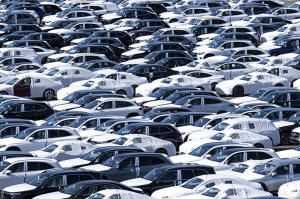Trump's tariffs aren't strictly reciprocal. Here's how he calculated
them
[April 04, 2025] By
WILL WEISSERT
WASHINGTON (AP) — President Donald Trump promised tariffs that would
raise U.S. import taxes high enough to mirror what others assess as
trade penalties on American goods.
What he's actually imposing is based on far more complicated math.
Here's a look at how the White House got its numbers:
Why do the new tariff rates often differ by country?
The Trump administration has declared an “economic emergency” to bypass
Congress and impose a 10% tariff on nearly all countries and
territories. It has set even higher levies for about 60 nations that it
says are the “worst” offenders.
The 10% global tariffs take effect at 12:01 a.m. Saturday. The higher
tariffs set for specific countries are due to kick in at one minute past
midnight on April 9.
Among the so-called worst offenders is China, which Trump argues protect
its producers through “malicious” trade practices in addition to
tariffs. Those efforts include actions such as imposing value added
taxes on all goods, dumping overproduced products on markets to
artificially deflate prices, or manipulating currency.
To determine how much higher those nations' rates should be, the White
House says it calculated the size of each country’s trade imbalance on
goods with the United States and divided that by how much America
imports from that nation.
It then took half that percentage and made it the new tariff rate.

Why not just charge reciprocal rates?
The White House says its calculations kept new tariffs from going even
higher for many countries and demonstrate that Trump is being “kind” to
global trading partners.
The administration maintains that creating a baseline levy with few
exemptions is necessary to keep China and others from skirting the new
tariffs by manufacturing goods and then shipping them to Vietnam,
Cambodia, Mexico or elsewhere to then be sent to the U.S.
That’s why the White House list of tariffed locations includes obscure
places like the Heard and McDonald Islands, which are uninhabited. They
are 2,550 miles (4,100 kilometers) from the coast of mainland Australia,
which claims them as a territory.
Is every country affected?
No. Canada and Mexico are excluded because they already are facing 25%
taxes on most imported goods that Trump announced last month, in an
attempt to force both to crack down on fentanyl smuggling into the U.S.
The White House originally said all others would be affected by at least
the 10% tariff. But administration officials clarified on Thursday that
countries already subject to stiff U.S. sanctions — for example, Russia
due to its invasion of Ukraine, as well as Iran, North Korea, Cuba,
Belarus and Venezuela — will not face the new, 10% global base tariff.
Officials said that is because sanctions and other existing barriers
mean the U.S. has so little trade with those places that deficits are
minimal.
Why is Trump doing this?
The president has spent months insisting America was at its wealthiest
at the end of the Gilded Age in the late 1800s and early 1900s, when it
imposed high tariffs as the key means of generating revenue for the
federal government.
[to top of second column] |

Cars are lined up before being loaded onto ships in the port at BLG
Autoterminal Bremerhaven, Germany, Tuesday, April 1, 2025. (Sina
Schuldt/dpa via AP)
 Trump even suggested Wednesday that
the U.S. moving away from higher tariffs and toward a federal income
tax in 1913 helped trigger the Great Depression of the 1930s — a
claim that economists and historians roundly reject.
A more contemporary explanation might be found in Project 2025, a
comprehensive blueprint compiled by leading conservatives about how
to shrink the federal workforce and push Washington further to the
right. It spelled out how Trump might impose high tariffs around the
globe, giving his administration more room to negotiate lower levies
with trading partners in exchange for U.S. priorities.
White House officials insist the new tariffs are more about closing
trade deficits, stimulating U.S. manufacturing and generating
government revenue than eventually negotiating new trading deals.
But Trump has shown he is willing to back off on threats of tariffs
in exchange for offers of concessions. His administration has said
the president is always ready to make deals, a sign the new tariffs
may prove to be more a bargaining chip than permanent policy.
Flying to Florida aboard Air Force One on Thursday, Trump said of
making possible deals to reduce tariffs imposed around the world
going forward, “Every country’s called us.”
“We put ourselves in the driver’s seat," he said. "If we would have
asked some of these countries, or most of these countries, to do us
a favor, they would have said, No. Now they’ll do anything for us.”
Why does US trade imbalances matter?
American trade policy created a U.S. trade imbalance worth $1.2
trillion last year, a gap that some experts believe should be
addressed in order to ensure the country's long-term economic
strength.
But many economists say the trade imbalances that Trump is looking
to correct are based on more than countries just using high tariffs
or protectionist trade practices to boost their own exports. Basing
the White House's tariff math solely on trade deficits, for
instance, fails to take into account U.S. consumer demand.

Americans relish buying BMWs assembled in Germany, as well as French
wine and coffee beans from Guatemala, and their spending can fuel
trade imbalances regardless of the tax and tariff policies of the
countries producing those goods.
That means any attempt to close U.S. trade gaps by tariffs will
likely mean increasing the cost of imported goods that Americans are
buying, which in turn could hurt the economy because of increased
inflationary pressures.
___
Associated Press writers Josh Boak and Zeke Miller contributed to
this report.
All contents © copyright 2025 Associated Press. All rights reserved |